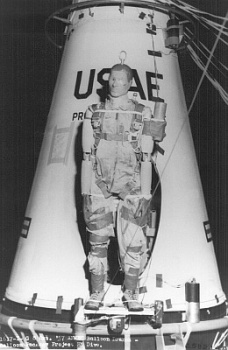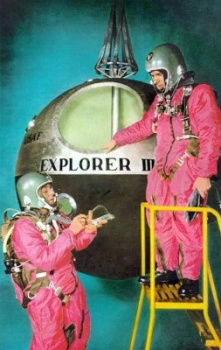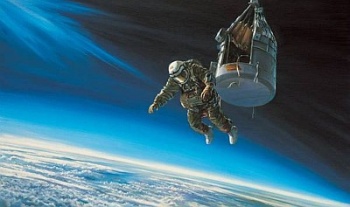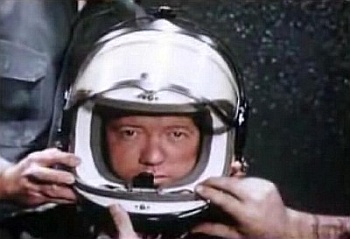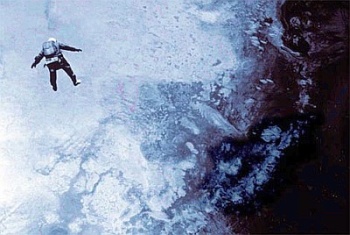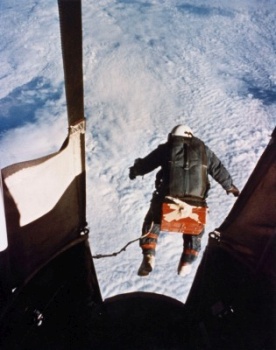On August 16, 1960, US Air Force Captain Joseph W. Kittinger literally jumped into the pages of aviation history books when he stepped out of a balloon gondola at an altitude of 102,800 feet. For more than four and a half minutes, he plummeted towards the ground before finally opening his parachute at an altitude of 18,000 feet. No person had ever parachuted to Earth from a higher altitude.
Context and Background
During the Second World War, aircraft routinely operated in the stratosphere, at altitudes above 40,000 feet. Pilots and air crew faced the problem of how to escape from an airplane flying at such altitudes. Would it be best to open a parachute immediately after exiting the aircraft, or should the escaping airman free fall to a lower altitude? Many people believed it would be best for a pilot to deploy his parachute as soon as he cleared the aircraft, but deploying a parachute in the stratosphere posed problems with severe opening shock, extremely low temperatures and a lack of oxygen.
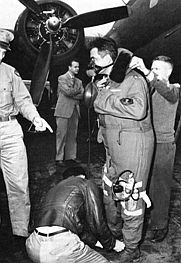
In 1943, US Army Air Force Flight Surgeon Colonel W. Randolph Lovelace studied the problem of high altitude escape and decided to perform an experiment using himself as a test subject. On June 23, 1943, he jumped from a B-17 Flying Fortress flying at 40.200 feet above Ephrata, Washington, USA. Carrying what was then a new piece of equipment - a bail-out bottle that held a twelve-minute supply of oxygen, he bailed out and opened the parachute. The 40-g opening shock knocked him unconscious; the blast tore the outer gloves off of both his hands. Fortunately, the oxygen bottle sustained him until he reached a lower altitude. Test pilot Perry Ritchie repeated the test a few days later and confirmed the only safe escape from the stratosphere was to freefall to a lower altitude. The following year, a series of dummy tests provided additional data.
Colonel Mel Boynton, another Army Air Force Flight Surgeon, decided to try a high altitude, low opening jump to test this technique for escape. This effort started badly when Colonel Boynton passed out in the altitude chamber. Boynton declined using an automatic activation device for his reserve parachute because "the troops didn't have it." He jumped from 41,000 feet and began a long freefall. Boynton never opened his parachute and was apparently still looking at his stopwatch when he hit the ground. This accident ended high altitude escape testing for several years.
In the years that followed World War II, aircraft successfully broke the sound barrier and reached unprecedented altitudes. As airplane performance increased, so did the need to develop techniques for high altitude escape, particularly from altitudes between 60,000 and 100,000 feet.
At the US Air Force Aero Medical Laboratory (situated at Wright Field, Dayton, Ohio) Lieutenant Edward G. Sperry picked up on the idea in 1952 and issued a formal Request for Proposal (RFP) for a gondola capable of sustaining a two-man crew for an ascent to 100,000 feet. Otto Winzen (founder and President of Winzen Research) responded on October 13, 1952 with a proposal to refurbish an existing (but never finished or flown) aluminum capsule he originally built for the cancelled US Navy Helios project. At the time, the Air Force did not award a contract or follow through with the RFP.
Project High Dive
The following year, the United States Air Force revived this line of research with Task 71719, "Altitude Escape Studies," as part of Project 7218, "Biophysics of Escape." Task 71719 became known as High Dive. To achieve the extreme altitudes necessary for High Dive, Air Force officials decided to use polyethylene balloons.
Project High Dive began in March 1953. Eleven months later, dummy drops from C-97 cargo aircraft flying at 30,000 feet began. Over the next two months, US Air Force personnel conducted a series of 28 drops over Holloman Air Force Base in southern New Mexico. In June 1954, High Dive progressed to a series of unstabilized dummy drops from up to 90,300 feet using high altitude balloons. Some of these flights carried more than one dummy. The tests confirmed that an unstabilized body would spin or tumble during freefall. The most extreme spin occurred on February 8, 1956, when dummy #2 on drop 53 reached 200 revolutions per minute (RPM) after being dropped from 89,000 feet.
While this work was underway, personnel at the Aero Medical Laboratory at Wright Field in Dayton, Ohio, constructed a 7-foot spherical gondola for live balloon jumps. While a sphere was the optimum shape for a pressure vessel, numerous shortcomings from an operational perspective soon became apparent. For one thing, the compound curve of the sphere made the design and fabrication of a light-weight, efficient hatch and frame almost impossible. There also wasn't enough head room for a standing occupant and the spherical shape made equipment placement difficult.
However, a photograph of Captain Edward Sperry and First Lieutenant Henry Nielson standing in front of the gondola appeared in the August, 1955 issue of The National Geographic Magazine. The photograph -which can be seen in detail clicking on the thumbnail at left- was in an article titled "Aviation Medicine on the Threshold of Space." According to the photograph caption, Sperry and Nielson intended to conduct a series of six flights and jump from the capsule at "extreme altitudes," around 90,000 feet.
Once the shortcomings of the spherical gondola became evident, the Air Force constructed a new, cylindrical-shaped capsule (image at right, click to enlarge). This capsule was used for many of the High Dive dummy drops.
After 22 balloon flights using unstabilized dummies, the Air Force progressed to the next phase of High Dive, where the dummies used stabilization parachutes to keep them from spinning. Results from the next series showed promise, but there was still one critical step that remained before the US Air Force could categorically declare that problems with high altitude escape had been solved. The dummies could not move their limbs or counteract any unwanted motion - a test series using a human test subject was needed.
In the mid-1950s, the US Air Force had a piloted high-altitude balloon project - Manhigh. Conducted by the Aeromedical Field Laboratory at Holloman, Project Manhigh investigated the effects of cosmic radiation on the human body by placing a pilot above 100,000 feet for 24 hours. The Manhigh capsule could also serve as a prototype for future spacecraft. Between June 1957 and October 1958, there were three piloted Manhigh flights (see detailed articles for the first mission Manhigh-I the second one Manhigh-II and the last of the project Manhigh-III on this web site). Captain Joseph W. Kittinger piloted Manhigh-1, which reached 97,000 feet on June 2, 1957. After the second Manhigh flight the following August, Kittinger was posted to the Aero Medical Laboratory at Wright Field where he undertook another balloon program - Project Excelsior. The problem of high altitude escape was once again receiving attention.
Project Excelsior
Excelsior was the manned extension of High Dive. Colonel John Paul Stapp commanded the Aero Medical Laboratory; during Manhigh, he'd been in charge of the Aeromedical Field Laboratory. Stapp selected the name Excelsior because it meant "ever upward" in Latin. Kittinger planned to use a balloon to reach the stratosphere. Then, he would jump from the aerostat and delay opening his main parachute until reaching 18,000 feet. Kittinger's involvement in both Manhigh and Excelsior has sometimes created confusion regarding the projects and his parachute jumps have been reported as part of Manhigh. However, the two projects were totally different and distinct efforts.
One of the challenges facing Kittinger was to find a technique that could be used by pilots who were not trained skydivers. The solution came from Francis Beaupre of the Aerospace Medical Division of the Wright Air Development Center. Beaupre devised a three-stage parachute system. After leaving the gondola, Kittinger would fall for 16 seconds to build up speed. Then, a spring-loaded 18-inch diameter pilot chute would deploy. Building up adequate airspeed before deploying the pilot chute was critical because if it deployed too early, it would flop around due to insufficient dynamic pressure in the thin air. The pilot chute, in turn, deployed a six-foot diameter drogue chute that stabilized Kittinger in a feet-to-earth position. Along with the drogue chute, about one-third of the 28-foot diameter round main canopy was released from the parachute pack. Once he reached 18,000 feet, the rest of the main was released. Because a pilot ejecting from a crippled airplane could not be counted on to manually pull his ripcord, the entire activation sequence was automatic.
Winzen Research, Inc., was the prime contractor for Excelsior. During 1956, Winzen developed the Sky-Car system to support low-altitude scientific research and ballooning instruction. The Sky-Car comprised a cylindrical frame gondola that was 56 inches in diameter and 40 inches tall made from steel tubing. The balloon train included a 40.4-foot diameter parachute as a backup in case the balloon malfunctioned. Winzen proposed to use a modified Sky-Car for Excelsior, which meant Kittinger would make the ascent in an open gondola.
Wanting to prove operational pilots could use the system, Kittinger wore an Air Force MC-3 partial pressure suit covered by insulated winter flying coveralls. This was one of the most severe tests ever made of the pressure suit. If either the suit or helmet failed, unconsciousness would come in 10 - 12 seconds, followed by death in 2 - 3 minutes. In addition to the pressure suit and parachute system, Kittinger carried a box containing oxygen, instruments and cameras. Wearing all his equipment, Kittinger tipped the scales at 320 pounds - more than twice his normal weight.
Following a series of 140 dummy tests with the Beaupre system at altitudes of up to 100,000 feet and three live jumps from a C-130 at 28,000 feet, Kittinger was ready for his first stratospheric jump. Although the Aero Medical Laboratory in Ohio sponsored Excelsior, field operations took place at Holloman Air Force Base. The adjacent White Sands Missile Range provided a 40- by 100-mile landing area, but the target area was "only" 11 miles on a side.
Excelsior I
Excelsior I took off from Truth or Consequences, New Mexico, on November 16, 1959. The balloon drifted east, arriving over White Sands Missile Range as Kittinger neared the intended jump altitude of 60,000 feet. As he climbed, the balloon slowly rotated., which was typical. Although the gondola had a sun shade around most of it to protect Kittinger from the sun, there was no cover over the entrance area. When the balloon rotated so the entrance faced the sun, the intense sunlight streamed in and reflected off the instrument panel, which glare-blinded Kittinger and made it impossible for him to read them. At the same time, another problem cropped up: the visor on his helmet began to fog over, further blocking his vision. The entire time, the balloon continued to ascend.
Now the helmet began to rise up as his suit pressurized. A series of steel wires and nylon webbing were supposed to prevent this, but Kittinger knew of one test in an altitude chamber where the webbing pulled free. Only the quick actions of the chamber operating crew saved the pilot. Flying at more than 12 miles above the Earth, there was nobody to rescue Kittinger should something similar happen to him. Before takeoff, life support technician Sergeant Frank Hale tied several pieces of nylon parachute shroud line between the helmet clasps and parachute harness. Although the helmet ultimately rose about two inches, the shroud line held it securely on Kittinger's shoulders.
Through a small clear spot on his visor, Kittinger noticed he was ascending through 65,000 feet. He opened the vent valve in the apex of the balloon to halt the climb. At X-minus five minutes, the faceplate suddenly cleared. Seventy seconds before jump, Kittinger jettisoned the radio antenna that hung below the gondola. Then, one by one, he disconnected the hoses and electrical cables that connected him to the gondola. It was time to jump. Kittinger tried to stand up, but found the instrument pack he wore was stuck in the seat! He grabbed the instrument panel and tried to pull himself up without success. Finally, with one last lunge, Captain Kittinger managed to free himself and stood up.
As he prepared to jump, Kittinger noted the balloon had climbed to 76,400 feet, more than three miles higher intended. Standing in the door of the gondola, he pulled the lanyard that activated the barometric release for the main canopy and the timer for the pilot chute. It took three tries to pull the lanyard clear. Unknown to Kittinger, the first pull started the timer. The result of this was the pilot chute deployed only 2.5 seconds after he left the balloon.
Without sufficient airspeed to create adequate dynamic pressure, the pilot chute flopped around in the thin air and eventually wrapped around his neck. He began spinning. At first, Kittinger could correct the spin, but soon he could no longer compensate for it and eventually blacked out. He didn't regain consciousness until he was floating beneath the reserve parachute several thousand feet above the ground. The pilot parachute had not deployed the drogue because it was tangled around his neck, so the main parachute never deployed. After Kittinger lost consciousness, the spin continued and eventually reached 80 RPM. A barometric release triggered the reserve parachute at 10,000 feet, but due to the spin, at first it tangled around him. Beaupre had planned for such a contingency and installed the reserve parachute pilot chute with a break-away cord that would enable the canopy to clear itself. Thankfully, the reserve cleared itself at 6,000 feet and inflated.
Excelsior II
Post flight analysis revealed a number of relatively small problems with the equipment that hadn't shown up in earlier testing. The aneroid activation and pilot chute timer knobs were redesigned. Sergeant Hale found a seemingly simple fix for the helmet problem: once the nylon webbing had been pulled taut, he sewed the ends together so it didn't matter if the clamp slipped or not. Finding a solution to the faceplate fogging problem required a change in testing locations. The altitude chamber at Wright Field could only reach a temperature of minus 70 degrees Fahrenheit. At altitude, Kittinger encountered temperatures of minus104 degrees. Holloman Air Force Base had an altitude chamber that could create such an extremely low temperature, so it was a matter of finding ways to reset the faceplate defogging system under more realistic flight conditions using this chamber. Some relatively minor adjustments to the gondola made sure Kittinger would not get stuck in the seat again. The problem with the sun glare on the instrument panel proved simplest of all to fix - all it required was a simple cardboard sunshade around the panel. Kittinger feared senior officers in the Air Force would decide that Excelsior was too dangerous after the close call of the first flight and was greatly relieved when Colonel Stapp told him the second flight was approved. All the fixes took less than a month to do.
Excelsior II took place on December 11, 1959. One hour after launch, Captain Kittinger was floating 74,700 feet above the New Mexico desert. This time, everything worked perfectly. Immediately after stepping off the gondola, Kittinger began a slow turn. He dropped one foot and lowered his arm and the turn stopped. Fourteen seconds after leaving the balloon, the pilot parachute deployed. The small parachute pulled out the drogue and the main canopy deployed at 18,000 feet, exactly as planned. This "roaring success" cleared the way for another test.
Excelsior III
Early on the morning of August 16, 1960, Kittinger prepared to board the balloon for the third jump. For this flight, the gondola carried two placards. One was a license plate that his son had cut off of a cereal box. His son was in Ohio, the license plate was from Oregon, and the flight took place in New Mexico. Such details didn't matter to the younger Kittinger - he felt the gondola needed a license plate. The other was a sign that read "This is the highest step in the world".
Excelsior III, launched from Tularosa, New Mexico, carried Kittinger to 102,800 feet. During the ascent, the pressurization in his right glove failed and his hand began to swell. It reached nearly twice its normal size and was very painful. Afraid that he would be ordered to jump early because of the malfunction, Kittinger did not report the problem until he was at altitude. Seventy seconds before jumping, he cut away the radio antenna to prevent hitting it. For the first time in the flight, Captain Kittinger was truly alone.
After stepping off "the highest step in the world," he fell on his right side for about eight seconds, then rolled over on his back to watch the silvery balloon against a black sky. Sixteen seconds after Kittinger left the gondola, the pilot chute sprang out, followed by the drogue that stabilized him. His top speed, reached at 90,000 feet, was an incredible 625.2 miles per hour! While falling under the drogue chute, he turned to face El Paso, Texas, then back to face New Mexico.
Suddenly, Kittinger felt as though he was being choked - the helmet was rising again. Fortunately, as his descent continued, the sensation eased. At 21,000 feet, Kittinger entered a solid layer of clouds. Instinctively, as though he were hitting a solid object, Kittinger drew his feet up. He'd never fallen through clouds before. The main parachute deployed four and a half minutes after he left the balloon, after a fall of just over 16 miles. He emerged from the clouds at 15,000 feet. Two helicopters circled around him as he descended to the desert floor.
Prior to landing, Kittinger was supposed to release the instrument box beneath his container. Only one side released, so he landed with its additional weight.
The landing was hard and the seat kit inflicted a severe bruise on his leg. Otherwise, he was unhurt. The helicopters landed at almost the same instant as Kittinger and medical technicians rushed to his aid. "I'm very glad to be back with you all," was how Kittinger greeted the recovery team.
The total time since leaving the balloon was 13 minutes, 45 seconds.
Excelsior and Red Bull Stratos
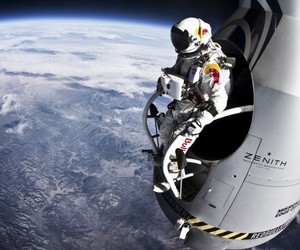
Joseph Kittinger was involved almost from it's inception in the Red Bull Stratos project, an sport/science effort to try to break the records achieved by him in the 60's and to test a future generation of hardware, pressure suits and techniques to advance the science and knowledge about high altitude bail-outs. The Austrian parachutist Felix Baumgartner was the pilot of the effort.
The participation of Kittinger in the project was as mentor and Capcom I, that is the voice that links the ground Control Center with the pilot. On October 14th, the project performed the third and final jump over New Mexico, managing to beat four of the five records that Kittinger owned.
As Stratocat's editor I want to pay my humble tribute not only to the men and women behind the Red Bull Stratos but to those who along history, contributed in one way or another to pave the way that led to this extraodinary jump. See our timeline:
About the author
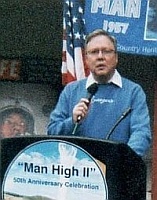
Gregory P. Kennedy is an internationally known expert in aerospace history. He has authored, co-authored, or edited eight books on space history including Touching Space: The Story of Project Manhigh, which was released by Schiffer Publishing Company of Atglen, Pennsylvania (www.schifferbooks.com).
He has also published numerous articles on the Manhigh project and recently appeared on a PBS documentary entitled "Space Men".
With nearly 40 years' experience in aviation and space museums, Mr. Kennedy has worked at the Smithsonian Institution; the Space Center; American Airlines C. R. Smith Museum; and No. 1 British Flying Training School Museum. While at the Smithsonian, he was Associate Curator for the National Air and Space Museum's collection of manned space flight artifacts.
It was during his tenure at the Smithsonian that he became fascinated with Project Manhigh and the contributions of high-altitude ballooning to space exploration. At the Space Center (currently known as the New Mexico Museum of Space History) in Alamogordo, New Mexico, Mr. Kennedy met many Project Manhigh personnel.

